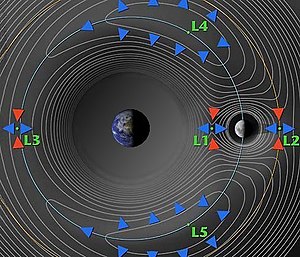Lagrange point colonization

Lagrange point colonization is a proposed form of space colonization[1] of the five equilibrium points in the orbit of a planet or its primary moon, called Lagrange points.
The Lagrange points L4 and L5 are stable if the mass of the larger body is at least 25 times the mass of the secondary body.[2][3] Thus, the points L4 and L5 in the Earth–Moon system have been proposed as possible sites for space colonies.[4][5] The L5 Society was founded to promote settlement by building space stations at these points.
Gerard K. O'Neill suggested in 1974 that the Earth–Moon L5 point, in particular, could fit several thousands of floating colonies, and would allow easy travel to and from the colonies due to the shallow effective potential at this point. A contemporary NASA team estimated that a 500,000-tonne colony would cost US$5.1 billion (equivalent to US$32 billion in 2023) to build.[4]
O'Neill proposed manufacturing large cylinders or spheres as colony habitats, while others proposed an enclosed torus shape or a huge ring without a "roof". Another approach is to move an asteroid to a Lagrange point with a colony in its hollow interior.
See also
[edit]References
[edit]- ^ Dorminey, Bruce (July 31, 2012). "Death Of A Sci-Fi Dream: Free-Floating Space Colonies Hit Economic Reality". Forbes. Retrieved December 17, 2018.
- ^ Fitzpatrick, Richard. "Stability of Lagrange Points". Newtonian Dynamics. University of Texas.
- ^ Greenspan, Thomas (January 7, 2014). "Stability of the Lagrange Points, L4 and L5" (PDF).
- ^ a b O'Neill, Gerard K. (September 1974). "The colonization of space". Physics Today. 27 (9): 32–40. Bibcode:1974PhT....27i..32O. doi:10.1063/1.3128863.
- ^ "The Lagrangian Points L4 and L5". pwg.gsfc.nasa.gov. NASA. Retrieved June 7, 2021.
External links
[edit]- Dictionary Definition
- European Space Agency
- Free Mars
- Orbital Vector Archived September 14, 2017, at the Wayback Machine
- NASA - The Moon and the Magnetotail


 French
French Deutsch
Deutsch